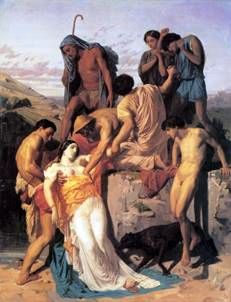
“Zenobia, found by shepherds on the banks of Araksa” – the work of the French artist Adolf Wilhelm Bouguereau, – was the starting point of the rising glory of the then young author and brought him the Roman Prize. What was imprinted on the plane of the canvas was only a small piece of the long history of the tortures of Zenobia – the wife of the ruler of Iberia.
Having become a victim of the jealous husband of Radamist, being on the run from the new ruler of the kingdom, Tiridata, the woman was wounded and thrown into the waters of the Araksa River. To spite the fate of the young queen was saved barely alive from the abyss of a mountain river by shepherds and accepted by Tiridat, who loved and respected her. The scene of rescue attracted the attention of Bouguereau. The retention of the outgoing life in the hair, the trembling with which the virgins of the virgin look at the lifeless body, the silence and expectation of awakening – torment the viewer. The impending canvas of silence is broken only by the rustle of water and clothes. Nature is practically asleep in the evening twilight.
The sun has not yet set, coloring the bodies of people with a crimson, and making the shadows sharper and blacker. Every smear and stroke of oil lives and melts under the feet of the shepherds. A sad scene, is not it? Captive the bodies of men. They are written in a believable way, as if they were written off from nature of different ages and estates: both a naked boy, a bent old man in a hood, and tanned shepherds younger.
Against the backdrop of the sand paint bodies of men Zenobia seems porcelain and fragile. Her body does not know the soot of the rays and the prickly wind. Water almost mummified the unfortunate tsarina with its coolness. That’s why the skin is white and the clothes are transparent.
Despite the crowding of characters, each of them is visible, you do not need to guess either the features of the face or the eyes. I want to pay tribute to the author’s skill to prescribe draperies with creases and folds, as well as complex moments of the landscape – stones, plants and a different basis of sand or rocks. The letter Bugero is dry and smooth, like a gloss. Art critics say that this is one of the first paintings written by Bugero in an uncharacteristic palette for the author – very bright, warm and clean. “Zenobia, found by shepherds on the banks of the Araksa” – a start for the following masterpieces with a similar underscore and color.
 Wave by Adolf Bugero
Wave by Adolf Bugero Idyll by Adolf Bugero
Idyll by Adolf Bugero Zenobia retrouvée par les bergers au bord de l’Arax – Adolf Bouguereau
Zenobia retrouvée par les bergers au bord de l’Arax – Adolf Bouguereau Earrings by Adolf Bugero
Earrings by Adolf Bugero Spring by Adolf Bugero
Spring by Adolf Bugero The Birth of Venus by Adolf Bugero
The Birth of Venus by Adolf Bugero Lullaby by Adolf Bugero
Lullaby by Adolf Bugero Love inspires by Adolf Bugero
Love inspires by Adolf Bugero